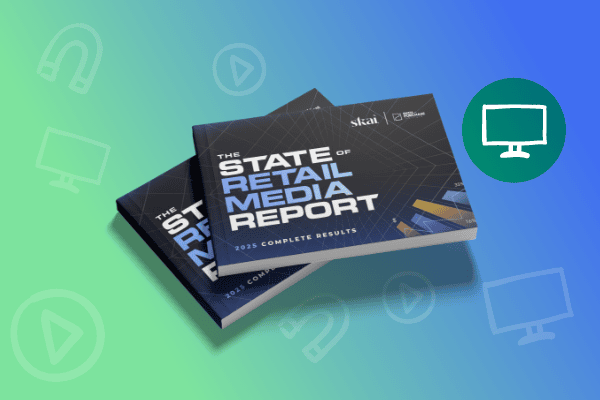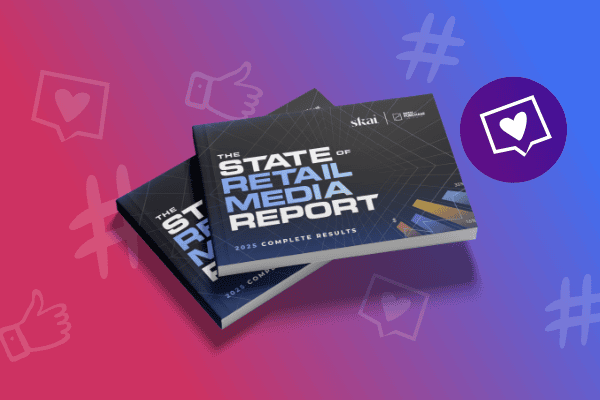Summary
A few years ago, many retail media marketers relied solely on Amazon or a few retail media networks (RMNs) like Walmart Connect or Instacart Ads. Today, the average marketer uses 6 RMNs, projected to reach 11 by 2025. With this growth, knowing when, where, why, and how to use each network is crucial. Strategic budget allocation across RMNs can mean the difference between success and wasted budget making a full-funnel approach vital for guiding consumers from awareness to conversion while maximizing ROI
NOTE – The content of today’s post is taken from Skai’s Full-Funnel Retail Media Formula report. Download and read the full report today.
The rapid rise of retail media networks has created unparalleled opportunities for brands to reach consumers across a wide variety of platforms. With over 200 RMNs now available, including retail giants like Amazon, Walmart, and Target, the market offers a wealth of data-driven, targeted engagement options.
However, in a full-funnel media approach networks are not just channels for exposure—they are integral components of a dynamic, evolving strategy that guides consumers through the entire purchase path.
Of course, working with just a few networks is easier than working with twice as many. But, to trade easy for right is not the mission. The goal is to always maximize the retail media budget for ROI like any other type of investing. Would you want your financial advisor to only work with a few stocks because it takes more time to evaluate the entire market? Of course not! There are now technologies that can reduce the resource costs of multi-network management so that it’s not much harder than managing a few.
Each network provides unique strengths, from targeted audience segments to advanced analytics, but leveraging these networks effectively means more than just tapping into them individually. A full-funnel retail media approach emphasizes the importance of selecting and combining RMNs strategically, ensuring that the right portfolio of networks play an ensemble role in seamlessly moving consumers from awareness to conversion, rather than working in isolation.
Beyond selecting the right networks, a full-funnel approach stresses the importance of business alignment—Joint Business Plans (JBPs) and strategic retailer relationships play a pivotal role in how media budgets are allocated and how well brands can leverage RMNs to meet their overarching business objectives. By aligning RMN selection with both media and business goals, brands can fully harness the power of retail media to drive meaningful results at every stage of the funnel.
A portfolio of retail media networks: always select the right tool for the job
In a landscape where over 200 retail media networks vie for attention, marketers must be strategic in their selection. Each network is at a different stage of its evolution, with varying capabilities and offerings. Understanding these nuances is essential for maximizing the impact of your retail media investments.
Amazon: The retail media titan
Amazon commands 89% of the retail media universe, making it a category in itself. As the largest and most advanced RMN, Amazon offers unparalleled reach and data-driven targeting capabilities that are difficult to match. Its robust ecosystem allows for precise consumer engagement across all stages of the funnel.
- Pros: Unmatched scale and reach, advanced data-driven targeting, comprehensive environment for consumer engagement. It also has exclusive inventory on devices (Alexa, Fire TV) and premium STV with Prime Video.
- Cons: High competition, complex management due to vast offerings.
Online-only retailers: Broad reach, focused impact
Networks like eBay, Instacart, and Etsy offer extensive reach and the ability to precisely target specific audiences. They are entirely digital, making them highly adaptable to real-time data and consumer behavior changes, but they require a deep understanding of ecommerce dynamics to leverage effectively.
- Pros: Strong digital presence, flexibility in targeting, real-time adaptability.
- Cons: High competition among advertisers, requires constant optimization and understanding of digital ecosystems.
Omnichannel retailers: Bridging the physical-digital divide
Omnichannel RMNs, such as those run by Walmart, Target, and Nordstrom, are on track to deliver the online-offline connection marketers have desired since the internet’s inception. These networks offer the ability to create cohesive consumer experiences across digital and physical stores, leveraging vast amounts of consumer data.
- Pros: Seamless integration across online and physical stores, access to comprehensive consumer data, ability to create cohesive customer experiences. They may also be able to report on offline sales from on-line campaigns (and vice versa).
- Cons: Complex management and synchronization across channels, higher operational costs.
Category-specific retailers: Deep specialization, focused audiences
Category-specific RMNs, such as Sephora in beauty or REI in outdoor gear, allow brands to target highly engaged and loyal customer bases. These networks are ideal for brands looking to leverage deep expertise and a focused approach to reach consumers already interested in their specific product categories.
- Pros: Highly targeted audiences, deep expertise in specific categories, strong brand loyalty from consumers.
- Cons: Limited reach compared to broader RMNs, highly dependent on specific sector trends.
Grocery retailers: The data-rich opportunity
Grocery RMNs like Kroger, Albertsons, and Publix offer a wealth of loyalty data that provides deep insights into consumer purchasing behavior. These networks are essential for brands in the food and beverage sector, providing consistent demand and opportunities for highly targeted promotions.
- Pros: Access to rich loyalty data, consistent demand, and opportunities for targeted promotions.
- Cons: Low profit margins, complex logistics for managing perishable goods.
Membership clubs: Leveraging loyalty for full-funnel engagement
Membership-based RMNs, such as those run by Costco and Sam’s Club, offer unique opportunities for full-funnel engagement due to the identified nature of their customer base. Every member interaction is tracked, providing detailed insights that can drive highly personalized marketing strategies.
- Pros: Highly loyal customer base, detailed consumer insights due to membership tracking, consistent engagement opportunities.
- Cons: Limited audience to members, higher expectations for personalized experiences.
Non-retailer networks: Exploring new frontiers
Non-retailer RMNs, like those launched by Chase, Marriott, and American Airlines, are still in their early stages but offer intriguing possibilities. These networks allow non-endemic brands to reach specific consumer segments through trusted platforms outside traditional retail channels.
- Pros: Diversify revenue streams, leverage existing customer relationships, offer unique targeting opportunities.
- Cons: Still evolving, may require different marketing and operational strategies, potential brand dilution if not managed carefully.
Engaging consumers across the funnel
The strength of retail media networks lies in their ability to connect with consumers across all stages of the funnel. From awareness to conversion, these networks offer unique touchpoints that can be leveraged to guide consumers through their journey. Whether through digital touchpoints like sponsored products on Amazon or physical placements in Walmart stores, the context in which consumers encounter your brand plays a critical role in how they engage with it.
Top of the Funnel: Targeting the Right Audiences
At the top of the funnel, the primary goal is to establish a strong presence and reach the right consumers. Different RMNs cater to varying demographics and psychographics, making it essential to select networks that align with your target audience. For example, Amazon provides extensive reach with a broad audience, while category-specific networks like Sephora or REI offer targeted access to niche markets. Consider the ad formats available as well; platforms that offer engaging formats like video ads or interactive displays can enhance visibility and drive initial interest. By choosing networks that resonate with your desired audience, you can effectively create awareness and interest in your brand.
Middle of the Funnel: Influencing Decision-Making
In the middle of the funnel, the focus shifts to actively shaping consumer decision criteria. Here, it’s vital to select RMNs that not only have access to your target audience but also offer the right ad formats to deliver persuasive messaging. For instance, omnichannel retailers like Walmart and Target can create cohesive experiences across online and in-store environments, allowing brands to engage consumers through personalized promotions and retargeting strategies. Meanwhile, online-only networks like Instacart can leverage real-time data to adapt messaging based on consumer behavior. Choosing networks that enable tailored, dynamic advertising will ensure your brand remains top-of-mind as consumers weigh their options.
Bottom of the Funnel: Driving Conversions with Tailored Strategies
At the bottom of the funnel, converting interest into action is paramount. This stage requires a focus on networks that provide the most relevant and impactful advertising opportunities. Grocery retailers, for instance, offer rich loyalty data that can inform targeted promotions, enhancing the likelihood of conversion. Similarly, membership-based networks like Costco allow for highly personalized marketing efforts that cater to known consumer preferences. By segmenting your audience and utilizing networks that enable precise targeting and frictionless purchasing experiences, you can effectively convert intent into action while also laying the groundwork for future loyalty.
Best Practices for Leveraging Retail Media Networks
Strategically allocate budgets. Marketers won’t be able to work with all 200+ networks, so it’s crucial to allocate budgets wisely. Focus on RMNs that align best with your brand’s target audience and overall objectives. Conduct thorough research to identify which networks not only provide reach but also align with specific consumer segments that matter most to your brand, ensuring that every dollar spent maximizes return on investment. Find networks where your competitors aren’t present so that you can dominate your category like you aren’t able to on Amazon.
Foster joint business plans. Building strong relationships with retailers through Joint Business Plans (JBPs) can significantly impact your success. These plans align mutual goals and provide additional leverage for your media program. By collaborating closely with retail partners, you can co-create strategies that capitalize on shared insights, enhancing the effectiveness of campaigns and fostering long-term partnerships that drive growth for both parties.
Know them inside and out. Each RMN is different, with varying options and capabilities. To maximize your investment, it’s essential to have a deep understanding of each network’s strengths and limitations. This includes staying updated on their latest features, audience insights, and advertising formats. By mastering the nuances of each network, you can tailor your approach to leverage their unique offerings effectively and navigate challenges more adeptly.
Utilize all available data. Retail media networks offer a wealth of data, from consumer behavior to campaign performance. Leveraging this data to its fullest potential is vital to optimizing your plan across all funnel stages. Take the time to analyze consumer interactions and feedback, allowing you to refine your targeting and messaging strategies continually. Employing advanced analytics tools can help you uncover actionable insights that drive more effective decision-making.
Continuously evaluate and optimize. As with any marketing strategy, continuous evaluation and optimization are critical. Regularly assess the performance of your RMN campaigns and be ready to pivot based on real-time data and insights. Establish a routine for analyzing key performance indicators (KPIs) and utilize A/B testing to explore new strategies. This iterative process not only helps improve current campaigns but also informs future initiatives, keeping your marketing efforts aligned with evolving consumer behaviors and preferences.
NOTE – The content of today’s post is taken from Skai’s Full-Funnel Retail Media Formula report. Download and read the full report today.







